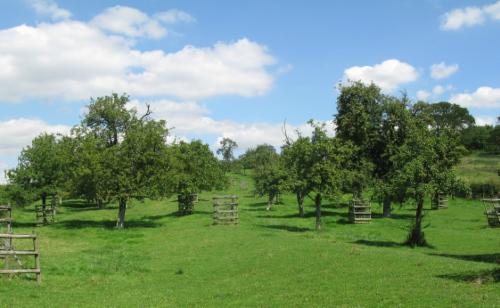Traditional orchards are those generally planted with large, well-spaced trees which have historically been managed without the input of fertiliser, pesticides or herbicide and where most of the work to maintain and harvest the orchard would have been done by hand. These less intensive management practices, coupled with a greater tolerance for allowing decaying and dead timber to remain in the orchard, results in many of these sites now being rich in wildlife.
The variety of habitat within traditional orchards can support a wealth of birds, mammals, invertebrates and plants including lichen, fungi and mosses as well as wildflowers on the orchard floor. Worcestershire is a hotspot for certain species that specialise in different elements of the orchard habitat, notably the Noble Chafer beetle and Mistletoe Marble moth. Both of these are UK Biodiversity Action Plan priorities. Follow the links in the left-hand menu for more information about these two species.
 Fruit trees generally have a shorter lifespan than other hardwoods and will begin to show evidence of the ageing process – hollowing, rot holes and cavities, sap runs etc – at a relatively early age: think 50-60 years compared to 300-400 for species such as oak. Wide spacing between the trees to promote the infiltration of sunlight to the ripening fruit also benefits insect life which in turn provides a rich food source for birds, supplemented by leftover fruit on which species such as redwing and fieldfare will feed over the winter.
Fruit trees generally have a shorter lifespan than other hardwoods and will begin to show evidence of the ageing process – hollowing, rot holes and cavities, sap runs etc – at a relatively early age: think 50-60 years compared to 300-400 for species such as oak. Wide spacing between the trees to promote the infiltration of sunlight to the ripening fruit also benefits insect life which in turn provides a rich food source for birds, supplemented by leftover fruit on which species such as redwing and fieldfare will feed over the winter.
Another feature of the traditional orchard is that the grassland beneath the trees is usually managed by grazing livestock rather than machinery or chemicals. If the grazing is carried out with the right intensity and timing the grassland can be maintained with a wildflower richness akin to a traditional hay meadow.
Common to many orchards in Worcestershire, but suprisingly scarce in other parts of the country, is mistletoe. The seeds of this parasitic plant are deposited on the branches by birds – sometimes in droppings but often by the bird cleaning its beak and pushing the seed into a crack in the bark. Too heavy a load of mistletoe will damage a fruit tree, both because of the parasitic nature of the plant and also because it adds weight and ‘sail area’ to the tree making it more vulnerable to storm damage – but a small amount is a bonus in any orchard due to the habitat the plant itself provides to wildlife, not least the mistletoe marble moth.
Good sources of further information on orchard wildlife can be found on the following websites:
People’s Trust for Endangered Species
Worcestershire Biological Records Centre is the county’s hub for the collection of habitat and species data. Any records of wildlife species, seen within an orchard or any other habitat, can be submitted to:
Worcestershire BRC
Lower Smite Farm
Smite Hill
Hindlip
Worcs
WR3 8SZ
records@wbrc.org.uk
01905 759759